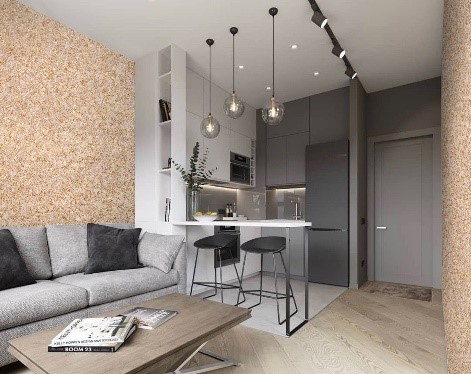Is it possible to use liquid wallpaper in the kitchen?
Looking ahead, let's just say – it’s possible! However, for the use of any material there are reasonable limitations associated with its properties. And what are those limitations will tell in detail.
In a modern kitchen there are different zones - this is a fact. There is a zone for cooking - we will designate it for convenience as a "technological zone". At the same time, in the vast majority of cases, there is a dining area that functions as a dining room, and maybe even a room for spending pleasant evenings together. Let's call it the "residential area".
 So, the technological zone requires mandatory constant washing, including with cleaning agents. And in such a zone it is reasonable to use only materials that satisfy this condition. Perfect materials are: varieties of ceramic, glass and stone tiles, corrosion-resistant metals (stainless steel, aluminum, copper), wood boards laminated according to the appropriate class, and of course plastic. Also, in this series, you can add a class of decorative plasters with a non-porous surface, highly resistant to constant exposure to water.
So, the technological zone requires mandatory constant washing, including with cleaning agents. And in such a zone it is reasonable to use only materials that satisfy this condition. Perfect materials are: varieties of ceramic, glass and stone tiles, corrosion-resistant metals (stainless steel, aluminum, copper), wood boards laminated according to the appropriate class, and of course plastic. Also, in this series, you can add a class of decorative plasters with a non-porous surface, highly resistant to constant exposure to water.
 It is important that the technological zone functions correctly. First of all, we mean the correct operation of the hood over the stove. If it is faulty, whether in passive or active modes, a characteristic "kitchen scurf" may form on the ceiling of the kitchen, and in difficult cases even on the walls. With proper ventilation, this should not be the issue.
It is important that the technological zone functions correctly. First of all, we mean the correct operation of the hood over the stove. If it is faulty, whether in passive or active modes, a characteristic "kitchen scurf" may form on the ceiling of the kitchen, and in difficult cases even on the walls. With proper ventilation, this should not be the issue.
If all these conditions are met, then for the living area, as well as for the entire ceiling of the kitchen, you can safely apply liquid wallpaper, as well as for any other residential part, without restrictions.
What is good liquid wallpaper for the kitchen?
 First, the kitchen is a high humidity zone. For example, rolled wallpaper does not tolerate such an atmosphere very well. At the same time, if there is no direct constant ingress of water, then the general humidity of liquid wallpaper is not a problem. We remember that in order to make liquid wallpaper plastic, a square meter must absorb at least 1.5 liters of water (with a wallpaper thickness of 1 mm). This is a priori an unattainable condition, so feel free to use liquid wallpaper in the kitchen.
First, the kitchen is a high humidity zone. For example, rolled wallpaper does not tolerate such an atmosphere very well. At the same time, if there is no direct constant ingress of water, then the general humidity of liquid wallpaper is not a problem. We remember that in order to make liquid wallpaper plastic, a square meter must absorb at least 1.5 liters of water (with a wallpaper thickness of 1 mm). This is a priori an unattainable condition, so feel free to use liquid wallpaper in the kitchen.
 Secondly, kitchens, as a rule, are small rooms, with rather complex geometry of walls, and even ceilings. And what can be better than other materials to solve this problem? I am sure that liquid wallpaper will give odds to any other material in such conditions both in terms of simplicity and speed of working with them.
Secondly, kitchens, as a rule, are small rooms, with rather complex geometry of walls, and even ceilings. And what can be better than other materials to solve this problem? I am sure that liquid wallpaper will give odds to any other material in such conditions both in terms of simplicity and speed of working with them.
Thirdly, the well-known fact that liquid wallpaper provides additional thermal insulation. For a small room, this is important because, being close to the walls, you will not feel the background cold. Those who have already used liquid wallpaper know this effect well.
 And of course, maintainability! It doesn’t matter what you accidentally stained the wall with: red wine, sauce, coffee… We don’t even talk about mechanical damage. All this is fast, and most importantly, it is easily corrected. And how exactly - watch the video at the link.
And of course, maintainability! It doesn’t matter what you accidentally stained the wall with: red wine, sauce, coffee… We don’t even talk about mechanical damage. All this is fast, and most importantly, it is easily corrected. And how exactly - watch the video at the link.
So, let's sum up. Liquid wallpaper in the living area of the kitchen, as well as on its ceiling, is not only possible, but also necessary! Considering all the advantages and simplicity, BIOPLAST liquid wallpaper will be an excellent stylistic addition, as well as a successful technological solution! Our online store will help you choose the most successful shades and textures, as well as visualize them in the interior.
Use modern materials, and trust professionals!
 +38 050 355 22 70
+38 050 355 22 70


